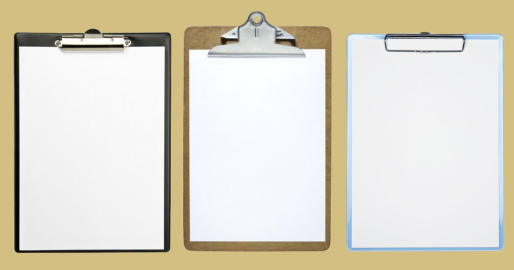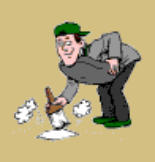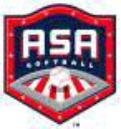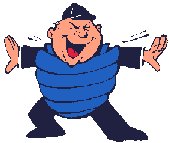© 2019

TIP OF THE WEEK
TIP OF THE WEEK
“Tri-County Umpire Group”


NEWS
2019 Baseball Season is Over
Our 2020 Meeting Dates will be posted soon.


How many different ways can
a pitcher balk?
When the pitcher:
1.
Switches his pitching stance from the windup position to the set position
(or vice versa) without properly disengaging the rubber;
2.
When going from the stretch to the set position, fails to make a complete
stop with his hands together before beginning to pitch;
3.
Throws from the rubber to a base without stepping toward (gaining
distance in the direction of) that base;
4.
Throws from the rubber to a base where there is no runner and no
possibility of a play.
5.
Steps or feints from the rubber to first base without completing the
throw.
6.
Pitches a quick return pitch, that is, pitches with the intent to catch the
batter off-guard.
7.
Pitches or mimics a part of his pitching motion while not in contact with
the rubber.
8.
Drops the ball while on the rubber.
9.
After a feint or throw to a base from the rubber, fails to disengage the
rubber before reengaging and pitching.
10.
after beginning to pitch, interrupts his pitching motion.
11.
Begins to pitch while the catcher is out of the catcher's box when giving
an intentional walk.
12.
While pitching, removes his pivot foot from the pitching rubber, except to
pivot or as a natural consequence of stepping forward to release the
pitch inordinately delays the game.
13.
Pitches while facing away from the batter;
After bringing his hands together on the rubber, separates them except
in making a pitch or a throw; or stands on or astride the rubber without
the ball, or mimics a pitch without the ball In addition, if a pitcher
commits any of the following illegal actions, it may result in a balk under
certain circumstances: expectorates on the ball, either hand or his glove;
rubs the ball on his glove, person or clothing; applies a foreign substance
of any kind to the ball; deface the ball in any manner; or delivers a ball
altered in a manner described above or what is called the “shine” ball,
“spit” ball, “mud” ball or “emery” ball.
More Balk Rules



Award of Bases
When the pitcher:
The basic thing to remember is awards are different when the
pitcher throws a ball out of play, versus a fielder:
When the pitcher throws the ball into dead ball territory while he is in
contact with the rubber, the runners are awarded one base from where
they were at the time of the windup.
If the pitch goes out of play on ball four, the batter only gets first base, but all
other runners get one base from the base they held at the time of the
pitch (windup). If the pitcher is not in contact with the rubber, he is a
fielder.
When any fielder throws the ball into dead ball territory, the runners are
awarded two bases.
The complicated part of this rule is deciding from what position the two
bases are awarded. There are several exceptions that can affect the
award. The award is either from the "time of pitch" (T.O.P.) or the "time of
throw" (T.O.T.). The time of throw means at the instant the ball leaves the
thrower's hand. Not the time the throw goes into dead ball area.
If the throw is the first play by an infielder, the award is, two bases from
where the runners were at the T.O.P. in 99% of the plays. There is an
exception that will be described later. The time of pitch is the start of the
windup or the moment the pitcher separates his hands from the set
position.
If the throw was the second play by an infielder, or any play by an outfielder,
the award is, two bases from the time the throw left the fielder's hand
(T.O.T.). The moment when the ball enters dead ball territory has no
effect on the determination of the placement of the runners. The
placement is from where the runners were at the time of the pitch or the
time the throw left the thrower's hand depending on whether the play
was the first play by an infielder or some other play.
A key thought to remember is: "first play in infield = time of pitch. Second
play or outfield = time of release." The award is, always two bases. The
only decision is: from where?
EXCEPTIONS: If ALL runners including the batter runner have advanced one
base before the first play by an infielder, the award is from time of
release. Otherwise, the award is from the time of the pitch. The key word
is “ALL.”
PLAY: Runner on second. A high pop-up is hit to the shortstop. The runner
holds. The shortstop drops the ball, and then throws to first attempting
to get the batter who has already rounded the base before the release of
the throw, and the ball enters dead ball territory. This was the first play
by an infielder, which means the award is from time of pitch. The
exception states that ALL runners must advance a base before the time
of release award is used. Because the runner at second held his base,
ALL runners did not advance before the throw, therefore, the award is
from time of pitch. The runner on second is awarded home and the
batter is awarded second. If the runner on second had advanced to third
before the throw to first, ALL runners would have advanced before the
throw, so the batter would be awarded third base and the runner on
second would get home.
A play for purposes of this rule is a legitimate attempt to retire a runner. A
throw to a base, an attempted tag or attempting to touch a base for a
force out are plays. A fake throw or fielding a batted ball, are not plays
for purposes of this rule.
PLAY. (a) Runner on first. Ground ball to SS. The throw to second is too late
and R1 is safe. The second baseman throws to first and the ball goes into
dead ball area. R1 is awarded home and the batter is awarded second.
The second baseman’s throw was the second play so time of release
applies. R1 was at second when the throw was made. The batter was not
at first at the time of the release.
PLAY. (b) Runner on first. Runner takes off on the pitch. Ground ball to SS.
The runner reaches second before the SS releases the throw to first that
then goes into dead ball area. R1 is only awarded third because the
throw was the first play by an infielder, which makes the award from the
time of pitch. R1 was at first at the time of pitch.

Follow the Bouncing Ball
When the pitcher:
1.
The ballgame is proceeding with no problems. The pitcher winds up and
throws a 44 foot pitch (or a 58 foot pitch on the 90 foot diamond.), the
ball bouncing in front of the catcher. Lots of things can happen then, and
lots of people have different ideas of the implications.
The Little League rule book says:
1. The batter swings and misses the bouncing ball. Ball is alive, umpire calls a
strike. Rule 2.00, “Ball”, “In Flight.”
2. The batter does not swing at the bouncing ball, but it goes through the
strike zone on the bounce. Ball is alive, umpire calls a ball. Rule 2.00,
“Ball”, “In Flight.”
3. The batter does not swing at the bouncing ball, and it does not go through
the strike zone. Ball is alive, umpire calls a ball. Rule 2.00, “Ball.”
4. The pitch bounces and hits the batter. The ball is dead, and the umpire
awards the batter first base. Rule 2.00, “Ball,” “In Flight,” 5.09 (a).
5. The batter swings and hits the bouncing ball. Ball is alive, play it as if it
didn’t bounce. Rule 2.00, “In Flight.”
6. The Junior, Senior or Big League division batter swings and misses, strike
three with first base empty or with two outs. The catcher catches the
bounced pitch, but the batter can STILL attempt to reach first base on the
“dropped” third strike. See Rule 2.00, “Ball,” “In Flight “(Because the pitch
hit the ground, it is no longer “in flight” and therefore, no longer a
“catch.”)
7. The pitcher accidentally throws the ball straight down; it hits the ground
and dribbles to a stop BEFORE crossing the foul line. The umpire calls
"time" and on the 60 ft., calls Illegal pitch (or on the 90 foot diamond with
runners on, Balk). See Rule 8.01(d).
8. The pitcher accidentally throws the ball straight down; it hits the ground
and dribbles to a stop AFTER crossing the foul line. Ball is alive, umpire
calls a ball. See rule 8.01(d).

Clarification on Rule 7.14
(the Little League "courtesy runner rule").
Can any player not in the line up at that time be a courtesy runner for
another player (not substituting)? Or is it only for a player who has NOT YET
BEEN IN THE LINE UP AT ANY TIME TO THAT POINT IN TIME?
We've seen the rule written and explained a couple different ways. The rule
seems to be written a little ambigious.
The end of the rule seems to say that this special runner (or any other
player) may be a courtesy runner again later in the game, whether they've
been in the line up or not to that point, as long as when they are put in as a
courtesy runner, that they are not, right then, in the line-up. (This end to the
rule implies that, in fact, the rule permits a player NOT THEN IN THE LINE UP
to be this kind of runner, and that whether or not the runner has ever been
in the line-up or not previsously in the game does not matter.)
So if A and B start the game for the home team and B is substituted for by C
on defense in the top of the 3rd inning. Can B run for A in the bottom of the
third? What if A bats before B's original place in the order? (This gets to
"when is a player 'removed' from the line up?) Can B then go back into the
field for C in the top of the 4th? If B does not go back for C in the 4th (and is
sitting on the bench), can B then run for D in the bottom of the fourth as a
courtesy runner for the second time in the game for a different player? Ok,
and the last one: Can B be doing all this courtesy running or not, but at any
time run for C on the bases regardless of whether another courtesy runner
has been used that inning or not because B, in that case, is a SUBSTITUTE for
C, and not a courtesy runner and so not subject to this rule at all?
Explanation:
So if A and B start the game for the home team and B is substituted for by C
on defense in the top of the 3rd inning. Can B run for A in the bottom of the
third?
Yes
What if A bats before B's original place in the order? (This gets to "when is a
player 'removed' from the line up?) [/b] Doesn't matter. A player is removed
when another legal player properly replaces the player.
Can B then go back into the field for C in the top of the 4th? Yes
If B does not go back for C in the 4th (and is sitting on the bench), can B then
run for D in the bottom of the fourth as a courtesy runner for the second
time in the game for a different player? Yes
Ok, and the last one: Can B be doing all this courtesy running or not, but at
any time run for C on the bases regardless of whether another courtesy
runner has been used that inning or not because B, in that case, is a
SUBSTITUTE for C, and not a courtesy runner and so not subject to this rule
at all? Yes, as a sub, but subject to reentry restrictions.

Infield Fly Situations
1/ With runners at first and second and none out, the batter hits a low pop-
up toward second base. But the second baseman, who had been holding the
runner on base is out of position. Dashing in at full speed, he dives for the
ball and misses. Although the umpire makes no call, the runners feel this is
an Infield Fly and hold their bases. The second baseman recovers, throws to
the third baseman who relays the ball to the shortstop covering second.
What is the proper call?
ANSWER
1/ This is a double play on the outs at third and second. Since the second
baseman could not catch the ball "with ordinary effort," the umpire did not
call Infield Fly. (2.00 Infield Fly)
2/ With runners on first and second, the batter lifts a one-out pop-up along
the first-base line. After the ump declares "Infield Fly, if Fair," the ball lands
on foul ground halfway between home and first, then spins into fair territory,
where it is picked up by the pitcher. The runner from second tries to go to
third but is pegged out by the hurler. What should the umpire rule?
ANSWER
2/ Since no one touched the ball until it went fair, it is a fair ball and the
batter is automatically out. The runner who was tagged is out also becuase
the runners advance at their peril in such instances. (2.00-Infield Fly, 6.05e,
7.08c)
3/ With the bases loaded and none out, the batter attempting to bunt pops
the ball into the air between the plate and the pitcher's mound. The ball
strikes the ground and spins back to the catcher, who is standing on home
plate. The catcher then tosses to the third baseman, standing on the bag,
who relays the ball to the second baseman at second. Fearing the ball would
be caught, all runners held their bases. What is the result of the play?
ANSWER
3/ An attempted bunt can never be an Infield Fly. Therefore, this was a triple
play, the first out coming on the catcher's touching home plate and the next
two on subsequent force outs at third and second. (2.00-Infield Fly-Force
Play, 7.08e)
4/ There are three men on base and one out when the batter lofts a high pop
fly over second base. As the second sacker drifts out under the ball, the
umpire calls "Infield Fly, if Fair". Then the center fielder, who had been
playing shallow, races in and tries to make a catch over his teammate's
shoulder. However, he drops the ball, retrieves it and fires over first
baseman's reach. When the play ends, two runs have scored, and runners
are on second and third. What about it?
ANSWER
4/ Even though an outfielder handles the ball, it remains an Infield Fly. Thus,
the batter is automatically out and is ordered off second base. But since the
ball remains in play on an Infield Fly, the other runners advanced legally.
(2.00-Infield Fly, 6.05e)
5/ With men on first and second and none out, the next hitter is expected to
sacrifice (wimpy national league ya know...). He shortens up as if to bunt, but
at the last moment draws back and swings away. He hits a low looper no
more than ten feet off the ground toward the third baseman. The umpire
calls "Infield Fly". Is he right in doing so?
ANSWER
5/ There is nothing in the rules defining how high an Infield Fly must go.
Since this is neither a line drive nor attempted bunt, the umpire is right in
calling it an Infield Fly if he feels it could be caught by an infielder with
ordinary effort. (2.00-Infield Fly).

BESR”
New High School Baseball Bat Standards
The National Federation of State High School Associations has adopted
standards for metal bats that limit the diameter of a bat to 2 5/8 inches.
Also, the weight-length differential can be no greater than three (e.g., a 32-
inch bat must weigh at least 29 ounces).
Umpires will be checking to ensure players are using bats with BESR
certification. Bats that can be used in high school games will be clearly
marked with a BESR designation. BESR stands for “Ball Exit Speed Ratio,” an
independent and scientific calculation designed to measure the performance
of non-wood bats.
The National Federation of State High School Associations (NFHS) adopted
the BESR bat performance standard in June 2001, a move that follows the
steps taken by the National Collegiate Athletic Association (NCAA) in 1999.
Elliot Hopkins, NFHS liaison to the Baseball Rules Committee, highlighted the
reasoning behind the rule change in a July 27, 2001 press release: "Adding
the BESR requirement for bats used in high school baseball is a continuation
of changes made for the 2001 season to ensure that bat performance
mirrors the performance of wood bats."
The Baseball Exit Speed Ratio (BESR) mark ensures a bat will have:
A maximum exit speed on the approved test which limits performance to
mirror the best Northern White Ash wood bats
Met the moment-of-inertia requirement (balance point)
A barrel diameter not exceeding a maximum of
2 5/8 inches
A length to weight differential of no greater than
minus 3
Item 5 - Baseball Divisions
Rule 1.10 - The bat must be a baseball bat which meets Little League
specifications and standards as noted in this rule. It shall be a smooth,
rounded stick and made of wood or of material and color tested and proved
acceptable to Little League standards.
It shall not be more than thirty-three (33) inches (34 inches for Junior; 36
inches for Big and Senior League) in length, nor more than two and one-
quarter (2 ¼) inches for Little League, 2 ¾ inches for Junior, and 2 ¾ for
wood-2 5/8 non wood for Senior and Big League in diameter, and if wood,
not less than fifteen-sixteenth (15/16) inches in diameter (7/8 inch for bats
less than 30") at its smallest part. Bats may be taped or fitted with a sleeve
for a distance not exceeding sixteen (16) inches (18 inches for
Junior/Senior/Big League Baseball) from the small end. Senior/Big League
baseball a bat shall not weigh, numerically, more than three ounces less than
the length (in inches) of the bat (e.g., a 33- inch-long bat cannot be less than
30 ounces).
Note 1: ……………Beginning with the 2009 season, non wood bats used in
divisions of Little League (league age 12 years old and younger) shall be
printed with a BPF (bat performance factor) of 1.15 or less. Senior and Big
League non wood bats shall meet the
BESR (Bat Exit Speed Ratio) performance standard, and such bats shall be
printed with a permanent certification mark.

Follow the Bouncing Ball
The official bat in ASA Championship Play must meet all of the requirements
of Rule 3, Section 1 and: must bear either the ASA approved 2000
certification mark or the ASA 2004 certification mark as shown below, and
must not be listed on an ASA non approved list, or must be included on a list
of approved bat models published by the ASA National Office; or must, in the
sole opinion and discretion of the umpire, have been manufactured prior to
2000 and if tested, would comply with the ASA bat performance standards
then in effect.
Beginning January 1, 2004, all bats in ASA Championship Play must pass the
ASA 2004 bat standard. All bats having the 2004 certification mark will be
allowed in ASA Championship Play. Bats that have the 2000 certification
mark will not be allowed in ASA Championship Play unless they are listed on
an approved bat list on the ASA website. For convenience, the ASA website
has a listing of bats that do not pass the ASA 2004 bat standard.
2004 and Beyond Approved Bats
For a list of bats that have been tested and found to comply with the ASA bat
performance standards, and therefore are authorized to bear the ASA 2004
certification mark and/or are authorized for use in ASA Championship Play
beginning January 1, 2004, please click on the link below. Manufacturers
continue to submit additional bat models for testing, and the ASA will update
this list as test results become available.ossing the foul line. Ball is alive,
umpire calls a ball. See rule 8.01(d).



ASA Bat Testing & Certification Program



285 School Lane
Springfield, PA 19064
(610) 543-1323
























































